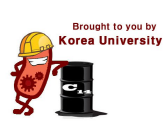Team:Korea U Seoul/Project
From 2011.igem.org
(→Overall project) |
(→Overall project) |
||
| Line 33: | Line 33: | ||
| - | <p> Goal of our project is to produce alkane chains from glucose molecules. In nature, numerous biochemical pathways and enzymes exist, making life adoptable to even extreme conditions such as volcanic regions. We focused on biochemical pathways, enzymes of glucose metabolism and luminescene luciferase from cyanobacteria to achieve our goal. Based on glycolysis, pyruvate oxidation, enzymes coded in luciferase genes (lux operon) and FAC from a, glucose is turned into alkane chain of about 14 carbon atoms in length. Synthesized fuel is functionally identical to natural petroleum and can be used as bioenergy. Produced alkane chain is part of a carbon circulation cycle as it is synthesized from glucose, in vivo. The fuel is relatively environment-friendly, unlike ordinary petroleum which increases CO2 concentration in the atmosphere. Though the production of alkanes using bioblock could be not satisfied commercially, succeeding in the synthesis of alkane chains from glucose nevertheless will show another method of producing alternative energy source. </p> | + | <p> Goal of our project is to produce alkane chains from glucose molecules. In nature, numerous biochemical pathways and enzymes exist, making life adoptable to even extreme conditions such as volcanic regions. We focused on biochemical pathways, enzymes of glucose metabolism and luminescene luciferase from cyanobacteria to achieve our goal. Based on glycolysis, pyruvate oxidation, enzymes coded in luciferase genes (lux operon) and FAC from a, glucose is turned into alkane chain of about 14 carbon atoms in length. Synthesized fuel is functionally identical to natural petroleum and can be used as bioenergy. Produced alkane chain is part of a carbon circulation cycle as it is synthesized from glucose, in vivo. The fuel is relatively environment-friendly, unlike ordinary petroleum which increases CO2 concentration in the atmosphere. Though the production of alkanes using bioblock could be not satisfied commercially, succeeding in the synthesis of alkane chains from glucose nevertheless will show another method of producing alternative energy source. Therefore, the success of this research will contribute to global effort in reducing atmospheric CO2 levels. </p> |
== Project Details== | == Project Details== | ||
Revision as of 02:23, 27 July 2011
| You can write a background of your team here. Give us a background of your team, the members, etc. Or tell us more about something of your choosing. | |
|
Tell us more about your project. Give us background. Use this is the abstract of your project. Be descriptive but concise (1-2 paragraphs) | File:Korea U Seoul team.png Your team picture |
| Team Example |
| Home | Team | Official Team Profile | Project | Parts Submitted to the Registry | Modeling | Notebook | Safety | Attributions |
|---|
Contents |
Overall project
Goal of our project is to produce alkane chains from glucose molecules. In nature, numerous biochemical pathways and enzymes exist, making life adoptable to even extreme conditions such as volcanic regions. We focused on biochemical pathways, enzymes of glucose metabolism and luminescene luciferase from cyanobacteria to achieve our goal. Based on glycolysis, pyruvate oxidation, enzymes coded in luciferase genes (lux operon) and FAC from a, glucose is turned into alkane chain of about 14 carbon atoms in length. Synthesized fuel is functionally identical to natural petroleum and can be used as bioenergy. Produced alkane chain is part of a carbon circulation cycle as it is synthesized from glucose, in vivo. The fuel is relatively environment-friendly, unlike ordinary petroleum which increases CO2 concentration in the atmosphere. Though the production of alkanes using bioblock could be not satisfied commercially, succeeding in the synthesis of alkane chains from glucose nevertheless will show another method of producing alternative energy source. Therefore, the success of this research will contribute to global effort in reducing atmospheric CO2 levels.
Project Details
Synthetic Fatty Acids Reduction Pathway
 "
"


